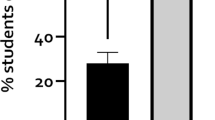Abstract
School education in Germany is under the responsibility of the federal states and as a consequence average grades differ widely across regions. Since school leavers apply nationwide for admission to university, regional provenance may thus matter a lot for the success probability in the admission process. Using a comprehensive dataset of the German central clearing house for university admissions in 2006/2007, we show that success rates indeed differ dramatically between federal states, provided that grades are not made comparable across state boundaries. Most of the variation in success can be explained by state-level differences in grading. By defining quotas for federal states and restricting competition among applicants to the state-level, the link between state-level grading and success rates in the university admission process can be broken.


Similar content being viewed by others
Notes
Grades in Germany are measured on a 1 to 6 scale with 1.0 being the top grade. The lowest passing grade is 4.0.
Austria, Belgium, Hungary, Poland, Sweden, and Switzerland also have a federal schooling system. In the United Kingdom schooling in Scotland takes on a special position. In the United States, in the Czech Republic and in Spain, regions have at least some influence on education.
Selection in stage 1 does not necessarily guarantee admission. Since strategic behavior on part of the applicants can alter the outcome at stage 2 (Braun et al. 2007), we concentrate on success in the selection stage. Here, success cannot be influenced by applicants’ behavior. For a more detailed description of admission at the second stage see Braun et al. (2007).
The reference date for the population data is 31st December, 2005. This is also the reference date which is used by the ZVS to establish the federal states quotas in procedure A.
The grade distributions do not only differ in terms of the mean but also with respect to the variance and the skewness. This becomes apparent in Fig. 3 in the Appendix that depicts the distributions of grades in Thuringia and Berlin and compares the two with the average over all 16 federal states. More detailed grade distributions for all 16 federal states are available from the authors upon request.
The quotas of young people getting their high school diploma differ largely between federal states (between 31.3 per cent and 52.4 per cent in 2005, German Federal Statistical Office 2007). One may be worried that the differences in the distributions of grades could be due to a selection of high-school graduates. A comparison of the quotas of young people with high school diploma across federal states shows that this seems not to be true: For instance, Baden-Württemberg and Berlin are quite similar with respect to the percentage of young people obtaining a high school diploma (Baden-Württemberg 44.0%, Berlin: 44.7%) but the shapes of their grade distributions are diametrically opposed. Hence, we conclude that the differences in distributions do not result from earlier selection processes.
The ZVS administers the procedures in a sequential order with U being the last procedure. If candidates are successful in a previous procedure, they do not longer participate in procedure U.
The point estimate should not be uniform across students. Regional provenance will not play a role for the highest ranked students. In contrast, for those students who are just getting in at the margin the influence of state-level grading may be much higher than estimated.
References
Administrative Court Munich/Verwaltungsgericht München (2005), M 3 E L 05.20578.
Braun, S., Dwenger, N., & Kübler, D. (2007). Telling the truth may not pay off: An empirical study of centralised university admissions in Germany. IZA Discussion Paper 3261.
German Federal Statistical Office. (2007). Hochschulen auf einen Blick. Wiesbaden: Statistisches Bundesamt.
Hochschulrahmengesetz (HRG). (1999). Bundesgesetzblatt, I(3), 18–34. http://bundesrecht.juris.de/bundesrecht/hrg/gesamt.pdf
Superior Administrative Court/Verwaltungsgerichtshof. (2006). 7 CE 06.10175.
UCAS.(2008). Tariff tables. http://www.ucas.com/students/ucas_tariff/tarifftables/.
Vergabeordnung Zentralstelle für die Vergabe von Studienplätzen (VergabeVO ZVS), as at May 2006.
ZVS. (2006). Auswahl- und Verteilungsgrenzen in bundesweit zulassungsbeschränkten Studiengängen zum Wintersemester 2006/2007. Dortmund: ZVS-Daten.
Acknowledgments
The authors are grateful to the ZVS for providing us with the dataset and in particular to Harald Canzler and Uwe Kuhnen. We also thank Viktor Steiner, Dorothee Schneider and two anonymous referees for valuable comments. The findings, interpretations, and conclusions expressed in this paper are entirely those of the authors. Sebastian Braun gratefully acknowledges support by the Deutsche Forschungsgemeinschaft through the SFB 649 ‘Economic Risk’.
Author information
Authors and Affiliations
Corresponding author
Additional information
An erratum to this article can be found at http://dx.doi.org/10.1007/s10734-009-9271-4
Rights and permissions
About this article
Cite this article
Braun, S., Dwenger, N. Success in the university admission process in Germany: regional provenance matters. High Educ 58, 71–80 (2009). https://doi.org/10.1007/s10734-008-9182-9
Received:
Accepted:
Published:
Issue Date:
DOI: https://doi.org/10.1007/s10734-008-9182-9





